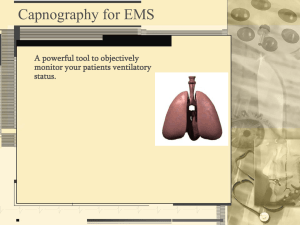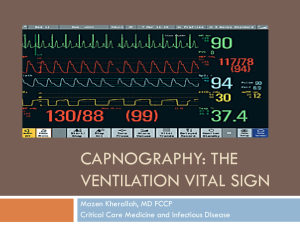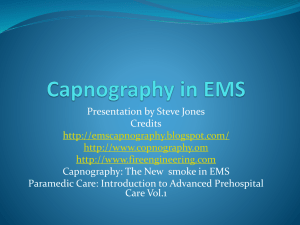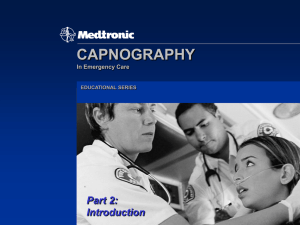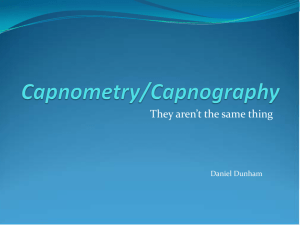capnography
advertisement
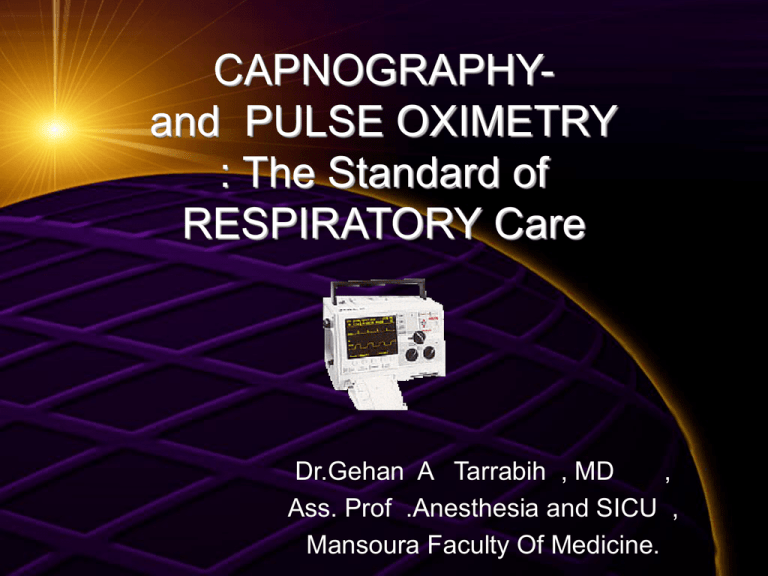
CAPNOGRAPHYand PULSE OXIMETRY : The Standard of RESPIRATORY Care Dr.Gehan A Tarrabih , MD , Ass. Prof .Anesthesia and SICU , Mansoura Faculty Of Medicine. CAPNOGRAPHY-OXIMETRY Why use them? Capnography & Pulse Oximetry CO2: Relects ventilation Detects apnea and hypoventilation immediately Should be used with pulse oximetry O2 Saturation: Reflects oxygenation 30 to 60 second lag in detecting apnea or hypoventilation Should be used with capnography Indications for Use End-Tidal CO2 Monitoring Validation of proper endotracheal tube placement Detection and Monitoring of Respiratory depression Hypoventilation Obstructive sleep apnea Procedural sedation Adjustment of parameter settings in mechanically ventilated patients ETCO2 & Cardiac Resuscitation Non-survivors Average ETCO2: 4-10 mmHg Survivors (to discharge) Average ETCO2: >30 mmHg ETCO2 & Cardiac Resuscitation If patient is intubated and pulmonary ventilation is consistent with bagging, ETCO2 will directly reflect cardiac output Flat waveform can establish PEA Increasing ETCO2 can alert to return of spontaneous circulation Configuration of waveform will change with obstruction Capnography What are we measuring? Respiration–The BIG Picture Capnography Depicts Respiration Physiological Factors Affecting ETCO2 Levels Normal Arterial & ETCO2 Values Deadspace CAPNOGRAPHY Theory of Operation Infrared Absorption A beam of infrared light energy is passed through a gas sample containing CO2 CO2 molecules absorb specific wavelengths of infrared light energy. Light emerging from sample is analyzed. A ration of the CO2 affected wavelengths to the non-affected wavelengths is re[ported as ETCO2 Capnography vs. Capnometry Capnography: Capnometry: Measurement and display of both ETCO2 value and capnogram (CO2 waveform) Measured by a capnograph Measurment and display of ETCO2 value (no waveform) Measured by a capnometer Mainstream vs. Sidestream Quantitative vs. Qualitative ETCO2 Quantitative ETCO2: Provides an actual numeric value Found in capnographs and capnometers Qualitative ETCO2: Only provides a range of values Termed “CO2 Detectors” Colorimetric CO2 Detectors A “detector” – not a monitor Uses chemically treated paper that changes color when exposed to CO2 Must match color to a range of values Requires six breaths before determination can be made CAPNOGRAPHY The Capnogram Elements of a Waveform Dead Space Beginning of exhalation Alveolar Gas Alveolar gas mixes with dead space End of exhalation Inspiration Value of the CO2 Waveform The Capnogram: Provides validation of the ETCO2 value Visual assessment of patient airway integrity Verification of proper ETT placement Assessment of ventilator/breathing circuit integrity The Normal CO2 Waveform A–B B–C C–D D D–E Baseline Expiratory Upstroke Expiratory Plateau ETCO2 value Inspiration begins Esophageal Tube A normal capnogram is the best evidence that the ETT is correctly positioned With an esophageal tube little or no CO2 is present Inadequate Seal Around ETT Possible causes: Leaky or deflated endotracheal or tracheostomy cuff Artificial airway too small for the patient Hypoventilation (increase in ETCO2) Possible causes: Decrease in respiratory rate Decrease in tidal volume Increase in metabolic rate Rapid rise in body temperature (hypothermia) Hyperventilation (decrease in ETCO2) Possible causes: Increase in respiratory rate Increase in tidal volume Decrease in metabolic rate Fall in body temperature (hyperthermia) Rebreathing Possible causes: Faulty expiratory valve Inadequate inspiratory flow Insufficient expiratory flow Malfunction of CO2 absorber system Obstruction Possible causes: Partially kinked or occluded artificial airway Presence of foreign body in the airway Obstruction in expiratory limb of the breathing circuit Bronchospasm Muscle Relaxants “Curare Cleft”: Appears when muscle relaxants begin to subside Depth of cleft is inversely proportional to degree of drug activity Faulty Ventilator Circuit Valve Baseline elevated Abnormal descending limb of capnogram Allows patient to rebreath exhaled gas Sudden Loss of Waveform Apnea Airway Obstruction Dislodged airway (esophageal) Airway disconnection Ventilator malfunction Cardiac Arrest QUIZ TIME #1 • Normal capnogram controlled ventilations spontaneous respirations #2 Muscle relaxants General anesthesia The cleft on the alveolar plateau is due to spontaneous respiratory effort #3 Normal capnogram Spontaneous ventilation in children Sampling from nasal cannula or O2 mask in adults #4 Esophageal intubation following a mask ventilation #5 Bronchospasm #6 Hyperventilation #7 Esophageal intubation #8 Contamination of CO2 sensor #9 Rebreathing #10 Flat line Waveform: Regular Shape, Plateau Below Normal • Indicates CO2 deficiency Hyperventilation Decreased pulmonary perfusion Hypothermia Decreased metabolism • Interventions Adjust ventilation rate Evaluate for adequate sedation Evaluate anxiety Conserve body heat Waveform: Regular Shape, Plateau Above Normal • Indicates increase in ETCO2 Hypoventilation Respiratory depressant drugs Increased metabolism Fever, pain, shivering • Interventions Adjust ventilation rate Decrease respiratory depressant drug dosages Assess pain management Conserve body heat Questions References Capnography, Bhavani Shankar Kodali, MD Capnography in ‘Out of Hospital’ Settings, Venkatesh Srinivasa, MD, Bhavani Shankar Kodali, MD Capnography, Novametrix Systems, Inc. Clinical Physiology of Capnography, Oridion Emergency Medical Services Evolutions/Revolutions: Respiratory Monitoring, RN/MCPHU Home Study Program CE Center End-Tidal Carbon Dioxide, M-Series, Zoll Medical Corporation
